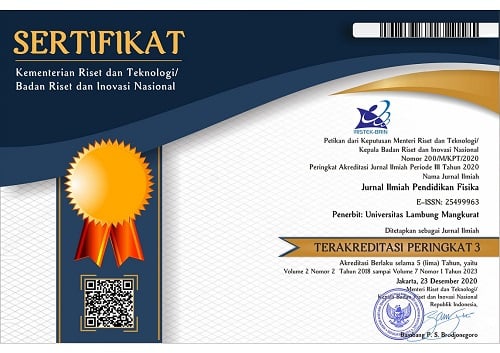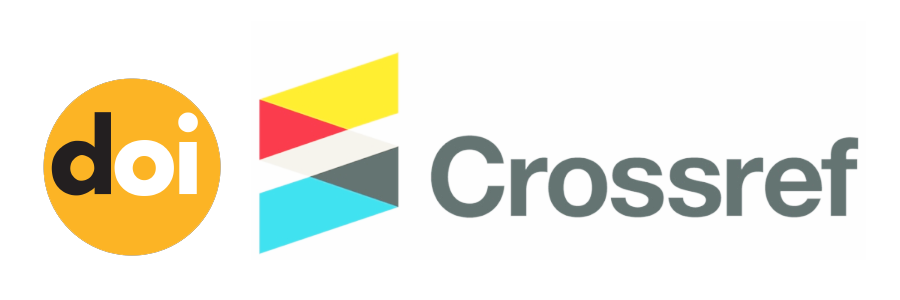Interactive Websites in Physics Education: A Bibliometric Analysis and Trends Review
Abstract
This study examines the trend and contribution of interactive websites in physics education through bibliometric analysis. Using R Bibliometrix, 38 articles from 1999 to 2024 were analyzed in annual scientific production, country scientific production, most cited countries, most cited documents globally, and word clouds. The types of documents obtained from the Scopus database in the form of articles, book chapters, conference papers, and conference reviews. The findings of the analysis show that the key trends include students, websites, e-learning, education, and teaching. While gaps remain in interactive learning tools, learning experiences, learning management systems, learning processes, and differentiation. This study could serve as a global guide for researchers and educators creating interactive physics learning websites.
Keywords
Full Text:
PDFReferences
Ady, W. N., & Warliani, R. (2022). Analisis kesulitan belajar siswa sma terhadap mata pelajaran fisika pada materi gerak lurus beraturan. Jurnal Pendidikan Dan Ilmu Fisika, 2(1), 104–108. https://doi.org/10.52434/jpif.v2i1.1599
Agbo, F. J., Sanusi, I. T., Oyelere, S. S., & Suhonen, J. (2021). Application of virtual reality in computer science education: A systemic review based on bibliometric and content analysis methods. Education Sciences, 11(3), 142. https://doi.org/10.3390/educsci11030142
Azizah, N., & Hendriyani, W. (2024). Implementasi penggunaan teknologi digital sebagai media pembelajaran pada pendidikan inklusi di indonesia. Jurnal Educatio, 10(2), 644–651. https://doi.org/10.31949/educatio.v10i2.8586 ISSN
Basitere, M., & Ivala, E. N. (2015). The effects of Wiley PLUS web-based homework system on student performance in the chemical engineering extended curriculum program: Introductory physics course. Proceedings of the International Conference on E-Learning, ICEL, 31–40.
Dasmo, Puji Lestari, A., & Alamsyah, M. (2020). Peningkatan hasil belajar fisika melalui penerapan media pembelajaran interaktif berbasis ispring suite 9. Prosiding Seminar Nasional Sains, 1(1), 99–102.
Dikshit, A., Wu, D., Wu, C., & Zhao, W. (2005). An online interactive simulation system for medical imaging education. Computerized Medical Imaging and Graphics, 29(6), 395–404.
https://doi.org/10.1016/j.compmedimag.2005.02.001
Donthu, N., Kumar, S., Mukherjee, D., Pandey, N., & Lim, W. M. (2021). How to conduct a bibliometric analysis: An overview and guidelines. Journal of Business Research, 133(April), 285–296. https://doi.org/10.1016/j.jbusres.2021.04.070
Dubyna, M., Popelo, O., Kholiavko, N., Zhavoronok, A., Fedyshyn, M., & Yakushko, I. (2022). Mapping the literature on financial behavior: A BIBLIOMETRIC ANALYSIS USING THE VOSVIEWER PROGRAM. WSEAS Transactions on Business and Economics, 19(December 2021), 231–246. https://doi.org/10.37394/23207.2022.19.22
Echchakoui, S. (2020). Why and how to merge Scopus and Web of Science during bibliometric analysis: the case of sales force literature from 1912 to 2019. Journal of Marketing Analytics, 8(3), 165–184. https://doi.org/10.1057/s41270-020-00081-9
Eslahpazir, B. A., Goldstone, J., Allemang, M. T., Wang, J. C., & Kashyap, V. S. (2014). Principal considerations for the contemporary high-fidelity endovascular simulator design used in training and evaluation. Journal of Vascular Surgery, 59(4), 1154–1162.
https://doi.org/10.1016/j.jvs.2013.11.074
Faridani, S., & Gramoll, K. (2008). Online interactive MEMS experiments and web-based curriculum. ASEE Annual Conference and Exposition, Conference Proceedings, 13.948.1-13.948.15. https://doi.org/10.18260/1-2--4190
Fisher, S. E., & Michielssen, E. (1999). An integrated online environment for antenna education. IEEE Antennas and Propagation Society International Symposium: Wireless Technologies and Information Networks, APS 1999 - Held in Conjunction with USNC/URSI National Radio Science Meeting, 1, 78–81.
https://doi.org/10.1109/APS.1999.789087
Foley, J. T., Mzoughi, T., Herring, S. D., Morris, M., Gillbert, P. J., & Moore, D. T. (2003). The optics project on the web (WebTOP). Optics InfoBase Conference Papers, 9663. https://doi.org/10.1117/12.2207350
González, J. D., Escobar, J. H., Sánchez, H., De La Hoz, J., & Beltrán, J. R. (2017). 2D and 3D virtual interactive laboratories of physics on Unity platform. Journal of Physics: Conference Series, 935(1), 012069. https://doi.org/10.1088/1742-6596/935/1/012069
Haleem, A., Javaid, M., Qadri, M. A., & Suman, R. (2022). Understanding the role of digital technologies in education: A review. Sustainable Operations and Computers, 3(February), 275–285. https://doi.org/10.1016/j.susoc.2022.05.004
Indriyanti, F., Fauziah, T. N., & Nuryadin, A. (2023). Analisis bibliometrik penggunaan video pembelajaran di sekolah dasar tahun 2013-2022 menggunakan aplikasi vosviewer. Jurnal Educatio, 9(1), 23–31. https://doi.org/10.31949/educatio.v9i1.3906
Iskandar, A., Winata, W., Kurdi, M. S., Sitompul, P. H. S., Kurdi, M. S., Nurhayati, S., Hasanah, M., Arisa, M. F., & Haluti, F. (2023). Peran Teknologi dalam dunia pendidikan (1st ed.). Yayasan Cendekiawan Inovasi Digital Indonesia.
Khlopov, M. Y. (2012). Virtual institute of astroparticle physics - science and education online. Bled Workshops in Physics, 13(2), 1–9.
Lefosse, D., van Timmeren, A., & Ratti, C. (2023). Biophilia upscaling: A systematic literature review based on a Three-Metric Approach. Sustainability (Switzerland), 15(22), 1–34. https://doi.org/10.3390/su152215702
Miller, B. T., Singh, R. P., Schalk, V., Pevzner, Y., Sun, J., Miller, C. S., Boresch, S., Ichiye, T., Brooks, B. R., & Woodcock, H. L. (2014). Web-based computational chemistry education with CHARMMing I: Lessons and tutorial. PLoS Computational Biology, 10(7), e1003719. https://doi.org/10.1371/journal.pcbi.1003719
Nagy, P., & Tasnádi, P. (2014). Zeeman catastrophe machines as a toolkit for teaching chaos. European Journal of Physics, 35(1), 1–22. https://doi.org/10.1088/0143-0807/35/1/015018
Novia, N., Permanasari, A., & Riandi, R. (2021). Research on educational games in STEM area 2010-2020: A bibliometric analysis of literature. Journal of Physics: Conference Series, 1806(1), 012209. https://doi.org/10.1088/1742-6596/1806/1/012209
Okoye, K., Nganji, J. T., Escamilla, J., Fung, J. M., & Hosseini, S. (2022). Impact of global government investment on education and research development: A comparative analysis and demystifying the science, technology, innovation, and education conundrum. Global Transitions, 4, 11–27. https://doi.org/10.1016/j.glt.2022.10.001
Pascual, T. N., Dondi, M., Paez, D., Kashyap, R., & Nunez-Miller, R. (2013). IAEA programs in empowering the nuclear medicine profession through online educational resources. Seminars in Nuclear Medicine, 43(3), 161–166. https://doi.org/10.1053/j.semnuclmed.2012.11.005
Perkins, K., Adams, W., Dubson, M., Finkelstein, N., Reid, S., Wieman, C., & Lemaster, R. (2004). PhET: Interactive simulations for teaching and learning physics. The Physics Teacher, 44(1), 18–23.
Prahani, B. K., Jatmiko, B., Amelia, T., Pristianti, M. C., Mahtari, S., & Uulaa, R. F. R. (2022). Web learning research in physics education during the covid-19 pandemic. Journal of Physics: Conference Series, 2392(1). https://doi.org/10.1088/1742-6596/2392/1/012002
Puspitasari, E. D. T., Surjono, H. D., & Minghat, A. D. (2018). Utilizing web based learning as 21st century learning media for vocational education. International Journal of Engineering and Technology(UAE), 7(4), 157–160. https://doi.org/10.14419/ijet.v7i4.33.23522
Rahmawati, Y., Febriyana, M. M., Bhakti, Y. B., Astuti, I. A. D., & Suendarti, M. (2022). Pengembangan media pembelajaran fisika berbasis game edukasi: Analisis bibliometrik menggunakan software vosviewer (2017-2022). Jurnal Penelitian Pembelajaran Fisika, 13(2),
–266. https://doi.org/10.26877/jp2f.v13i2.13170
Raudah, Mansur, H., & Satrio, A. (2021). Pengembangan media pembelajaran interaktif carrd.co untuk menyonsong pendidikan di abad 21. Journal of Instructional Technology, 2(2), 151–159.
Roselli, R., Gilbert, S. B., Howard, L., Blessing, S. B., Raut, A., & Pandian, P. (2008). Integration of an intelligent tutoring system with a web-based authoring system to develop online homework assignments with formative feedback. ASEE Annual Conference and Exposition, Conference Proceedings. https://doi.org/10.18260/1-2--4020
Santika, I. G. N. (2021). Grand desain kebijakan strategis pemerintah dalam bidang pendidikan untuk menghadapi revolusi industri 4.0. Jurnal Education and Development, 9(2), 369–377.
Susanto, A., Saleh, M., Putri, K., & Annisa, N. (2024). Pelatihan pengembangan media pembelajaran fisika berbasis website menggunakan platform wix pada materi gelombang mekanik di sma negeri 5 takalar. Nanggroe: Jurnal Pengabdian Cendikia, 3(7), 1–8. https://doi.org/10.5281/zenodo.13882650
Susanty, A. I., Artadita, S., Pradana, M., Neo, T.-K., Neo, M., & Amphawan, A. (2022). Twenty years of cooperative learning: A data analytic with bibliometric approach. 2022 International Conference Advancement in Data Science, E-Learning and Information Systems (ICADEIS). https://doi.org/10.1109/ICADEIS56544.2022.10037477
Tekdal, M. (2021). Trends and development in research on computational thinking. Education and Information Technologies, 26(5), 6499–6529.
Tsalist, S. L., & Habibulloh, M. (2023). Analisis bibliometrik penggunaan e-learning moodle dalam pembelajaran fisika. Seminar Nasional Fisika (SNF), 18–25. https://fisika.fmipa.unesa.ac.id/proceedings/index.php/snf/article/view/206
Vo, M. K., & Sharp, J. C. (2019). Design, development, and content creation for an open education physics website for mrt education. Journal of Medical Imaging and Radiation Sciences, 50(2), 212–219. https://doi.org/10.1016/j.jmir.2019.03.180
Wahyuningrum, T., Kartiko, C., Wardhana, A. C., & Soares, T. G. (2021). Revised web impact factor analysis of timor leste university website during covid-19 pandemic. Bulletin of Electrical Engineering and Informatics, 10(3), 1678–1686.
https://doi.org/10.11591/eei.v10i3.3034
Wibowo, F. C., Darman, D. R., Guntara, Y., Nulhakim, L., Prahani, B. K., Kurniawan, B. R., Fatkhomi, F., Siwanto, Prajoko, S., Ahmad, N. J., & Karlin, K. A. A. (2024). Unveil creative thinking in the physics education: Bibliometric analysis and literature review. AIP Conference Proceedings, 3116(1). https://doi.org/10.1063/5.0210197
Zatarain-Cabada, R., Barrón-Estrada, M. L., Cárdenas-Sainz, B. A., & Chavez-Echeagaray, M. E. (2023). Experiences of web-based extended reality technologies for physics education. Computer Applications in Engineering Education, 31(1), 63–82. https://doi.org/10.1002/cae.22571
DOI: https://doi.org/10.20527/jipf.v8i3.14190
Refbacks
- There are currently no refbacks.
Indexed by: Jurnal Ilmiah Pendidikan Fisika is licensed under a creative commons attribution-share alike 4.0 international license
Statistics Counter |
















